Introduction
In the rapidly evolving landscape of healthcare, physicians must navigate the complexities of digital marketing to effectively reach and engage patients. As more individuals turn to online resources for their healthcare needs, understanding the digital environment becomes paramount.
This article delves into the essential strategies physicians can adopt to enhance their online presence:
- Optimizing websites
- Leveraging social media
- Implementing data-driven marketing approaches
By recognizing patient preferences and utilizing innovative tools, healthcare providers can not only improve visibility but also foster meaningful connections with their audience, ensuring sustained growth in an increasingly competitive field.
Understanding the Digital Landscape for Physicians
To successfully implement effective physician digital marketing strategies, it is crucial for physicians to comprehend the digital landscape. This entails acknowledging the increasing inclination of individuals to depend on online information when pursuing medical services. Recent trends indicate that 74% of individuals are open to using telehealth services, and there has been a 40% increase in teleconsultation volumes, reflecting a significant shift in preferences towards convenient medical solutions.
Key components to consider include:
- Healthcare Needs: Conducting surveys and gathering feedback is essential to understand what individuals prioritize when searching for a healthcare provider online. This insight enables clinics to align their services with client expectations.
- Digital Tools: Familiarity with tools such as Google Analytics is vital for monitoring online behavior and engagement. By utilizing these tools, physicians can gain a clearer picture of how individuals engage with their online presence.
- Competitor Analysis: Evaluating how other clinics present themselves online can uncover gaps and opportunities in your own digital approach. Grasping the competitive environment enables clinics to distinguish themselves successfully.
Moreover, it’s essential to evaluate the financial consequences of efficient physician digital marketing; the average cost for an organic medical lead is $320, highlighting the necessity for strategic investment in these initiatives. Additionally, examining case studies like Amwell’s audience demographics—where 45.45% of users are male and 54.55% are female, mainly within the 25-34 age group—can offer insights into how grasping user demographics can affect promotional strategies. By understanding these foundational aspects, physicians can improve their marketing efforts to better meet expectations and enhance their clinic’s visibility in an increasingly digital healthcare environment.
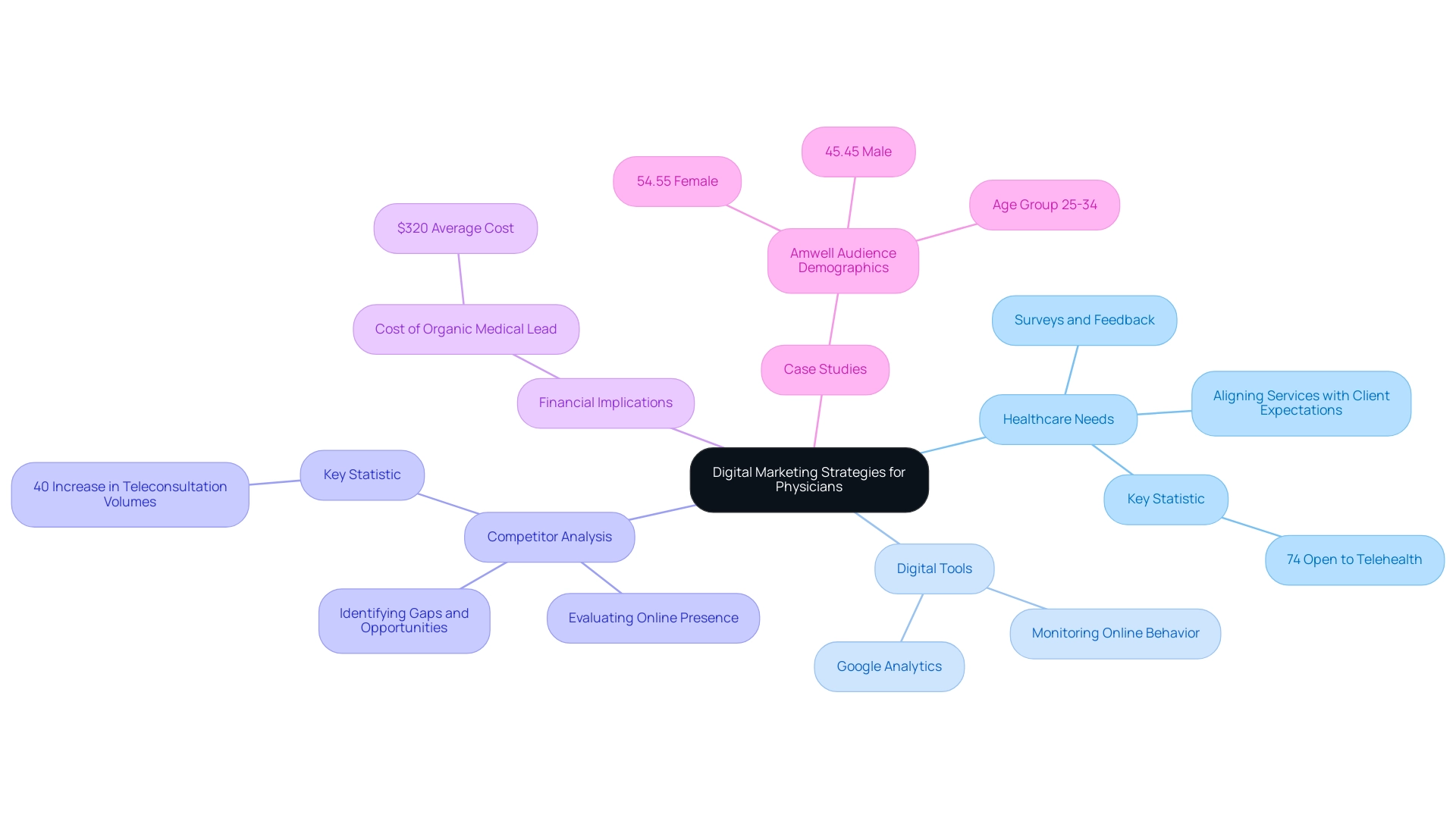
Building a Patient-Centric Online Presence
Creating a client-focused online presence through physician digital marketing necessitates a strategic approach that prioritizes the needs and preferences of prospective clients. Here are essential steps to consider:
-
Effective physician digital marketing requires a well-optimized website to attract and retain visitors. Ensure that your site is user-friendly and mobile-responsive, providing essential information such as services offered, location, and contact details prominently. Research indicates that nearly 75% of users judge a company’s credibility based on its physician digital marketing, particularly its website design.
-
Optimizing your Google Business Profile is essential for improving visibility among nearby clients through physician digital marketing. Incorporate relevant local keywords throughout your profile and website content. Additionally, encourage satisfied individuals to leave positive reviews, as feedback significantly influences new client decisions. A recent survey indicated that practices with optimized local SEO effectively enhanced their visibility, leading to a significant influx of clients.
-
Content Quality: Developing high-quality, informative content is key to establishing your practice as a trusted resource in the field of physician digital marketing. Address common patient queries and concerns through blog posts, FAQs, and educational articles. This not only improves your online reputation but also addresses the increasing need for informative content, as shown by the statistic that 1 in 2 content creation initiatives produce at least a 20% return on investment. As Abby Roy, a Digital Marketing Specialist at Forge Apollo, states, “Just as healthcare providers must stay current on new research and treatment practices, marketers should stay current on new physician digital marketing statistics and tactics.”
-
Accessibility: Ensuring your website meets accessibility standards is essential for providing equal access to all individuals, including those with disabilities. Following these standards not only expands your clientele but also shows your dedication to inclusivity.
-
Embrace Digital Trends: With telemedicine adoption anticipated to increase by 20% each year until 2024, implementing physician digital marketing strategies is essential for remaining relevant in the changing medical environment.
Applying these methods will create a friendly online atmosphere that effectively addresses client needs, ultimately resulting in enhanced practice growth and better branding.
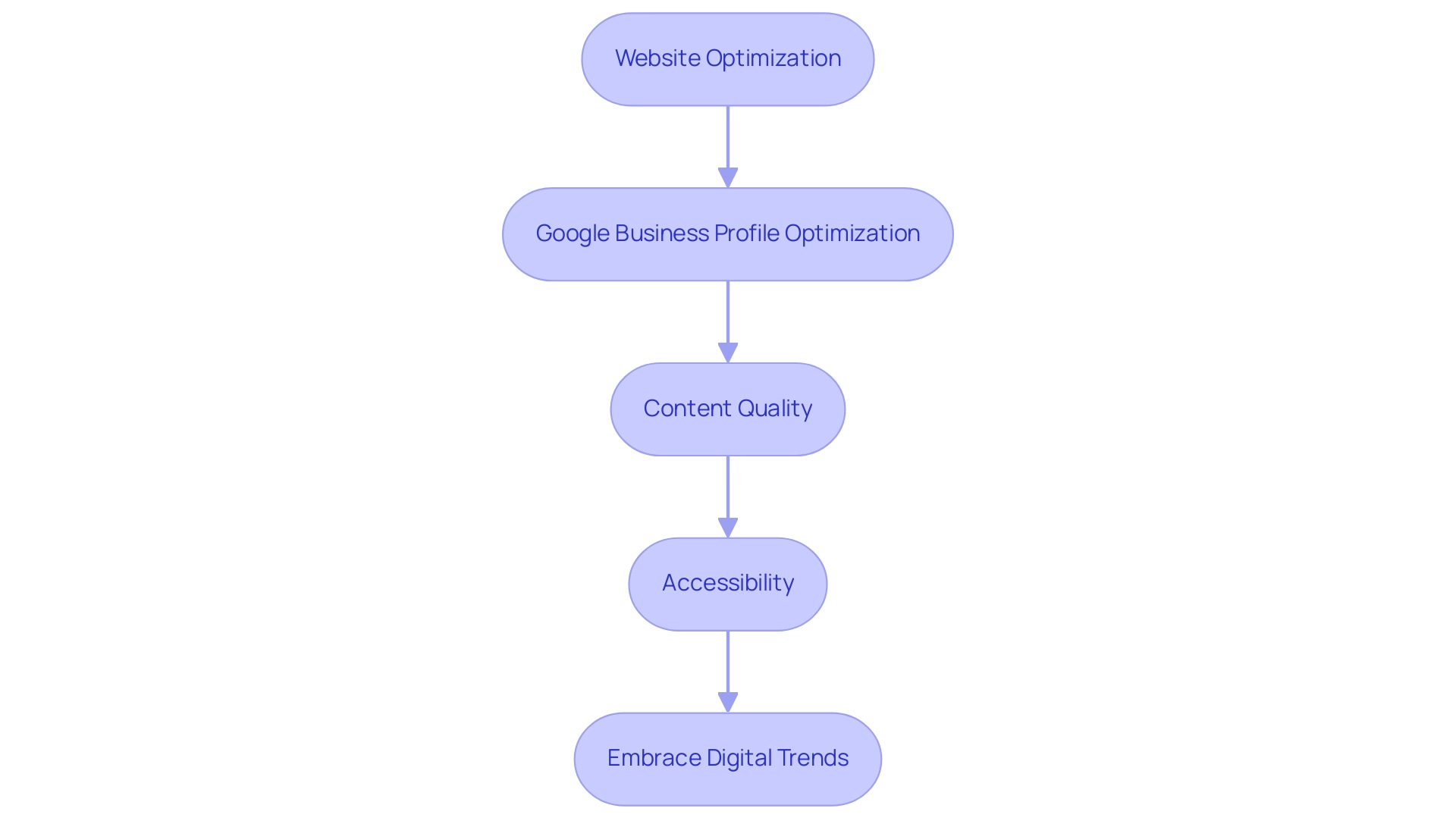
Leveraging Social Media and Content Marketing for Engagement
To effectively harness the potential of social media and content promotion in the healthcare sector, clinic owners should implement the following strategies:
-
Choose the Right Platforms: Understanding the digital landscape is crucial. With Facebook being the most popular social media platform among over 1,500 hospitals nationwide, it is essential to identify where your clients are most active. Focus your marketing efforts on platforms that resonate with your target audience, such as Facebook, Instagram, or LinkedIn. This strategic choice is supported by the systematic review on social media uses for health purposes, which underscores the importance of selecting platforms that advance health research and mobilize communities.
-
Content Creation: Valuable content is key to engagement. Share informative materials such as health tips, client testimonials, and pertinent industry news. Utilizing formats like videos and infographics can enhance comprehension and retention of information, making it more accessible for your audience.
-
Engagement: Building a community requires active participation. Respond promptly to comments and messages, as this fosters a sense of trust and connection between your practice and clients. Engagement metrics, such as response time and interaction rates, should be monitored to gauge effectiveness. However, it is important to be aware of privacy concerns related to social media usage; establishing clear guidelines for user interactions can help mitigate these issues.
-
Regular Posting Schedule: Consistency is vital. Establish a regular posting schedule to keep your audience informed and engaged. This method not only preserves visibility but also strengthens your dedication to education and communication with clients.
By effectively utilizing physician digital marketing techniques to interact with individuals, physicians can improve their practice’s visibility, cultivate client loyalty, and create a respected online presence that aids in long-term growth. The systematic review on social media uses for health purposes highlights new applications that advance health research and mobilize communities, while also pointing out existing research gaps that deserve further exploration.
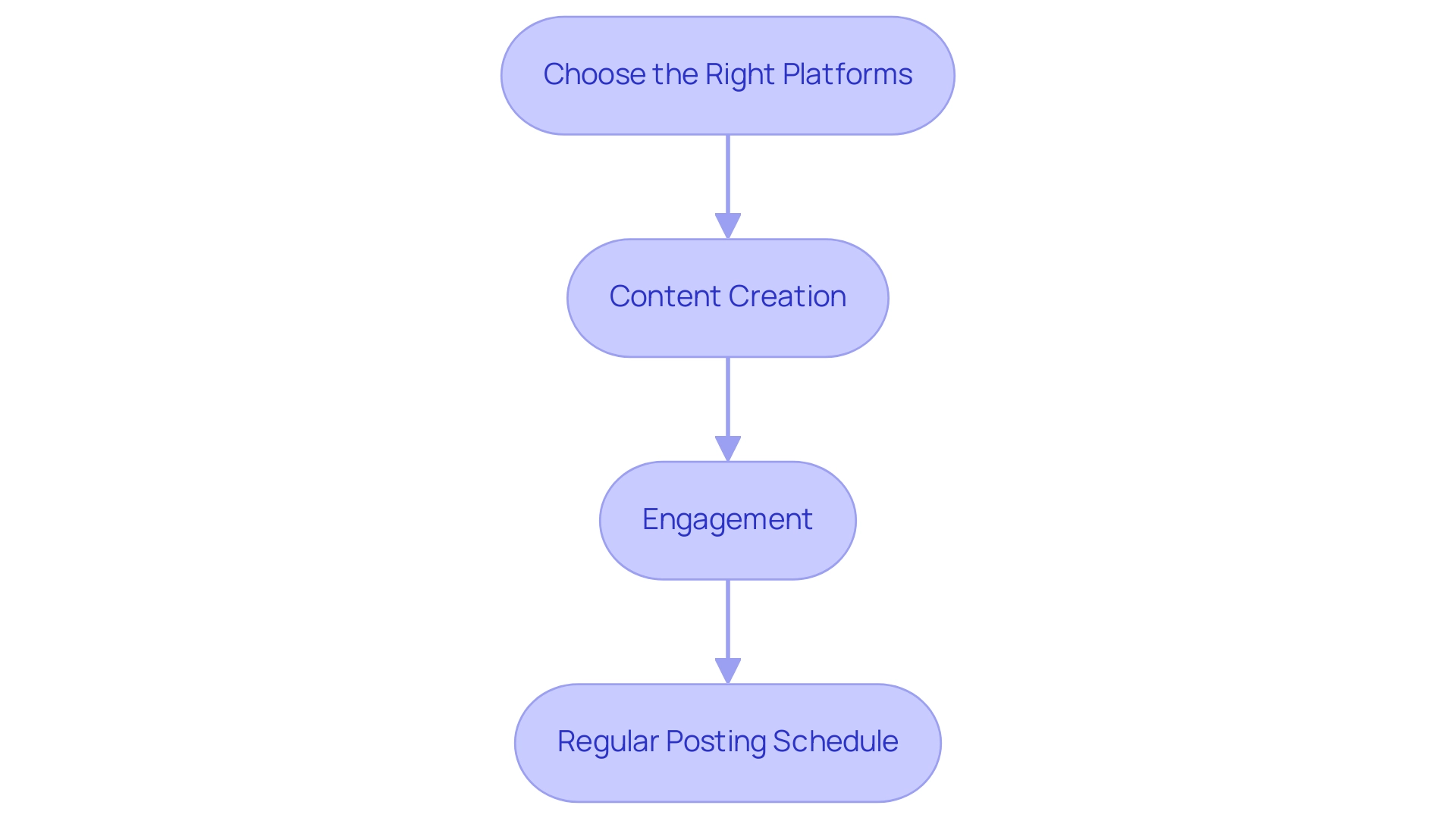
Implementing Data-Driven Marketing Strategies
Applying data-informed promotional techniques in the healthcare sector necessitates a systematic approach. Follow these steps to ensure effective execution:
-
Set Clear Objectives: Establish specific goals for your promotional initiatives, such as increasing inquiries from clients or enhancing website traffic.
These objectives will direct your overall approach and help assess success. -
Utilize Analytics Tools: Leverage advanced analytics platforms like Google Analytics and social media insights to monitor key performance indicators, including website visits, bounce rates, and conversion rates.
These metrics offer invaluable insights into individual behavior and preferences, informing future marketing decisions. -
PPC Campaigns: Allocate resources to pay-per-click (PPC) advertising, focusing on targeted demographics and relevant keywords that resonate with your practice.
Regularly monitor these campaigns to refine strategies and improve performance, ensuring optimal return on investment. -
Reputation Management: Actively manage your online reputation by monitoring reviews and feedback from clients.
Addressing concerns in a timely manner not only fosters a positive online image but also enhances trust and retention among clients. -
Utilize Physician Digital Marketing: In today’s competitive market, practices must emphasize the use of physician digital marketing and create engaging content to attract and retain individuals.
This method aids in distinguishing from rivals and aligns with the changing preferences of individuals.
By using data to guide physician digital marketing strategies, healthcare providers can make strategic choices that significantly enhance practice growth and engagement.
For example, with 58% of individuals preferring providers who offer telehealth services, promoting these options becomes essential.
As telemedicine usage is projected to grow by 20% annually through 2024, practices must educate patients on the advantages of telehealth to meet this rising demand.
Furthermore, automation in medical promotion has considerably decreased administrative expenses by $122 billion, highlighting the necessity for contemporary promotional strategies.
As noted by industry experts, ‘Data-driven promotion is not just an option; it’s a necessity for healthcare providers looking to thrive in a digital-first world.
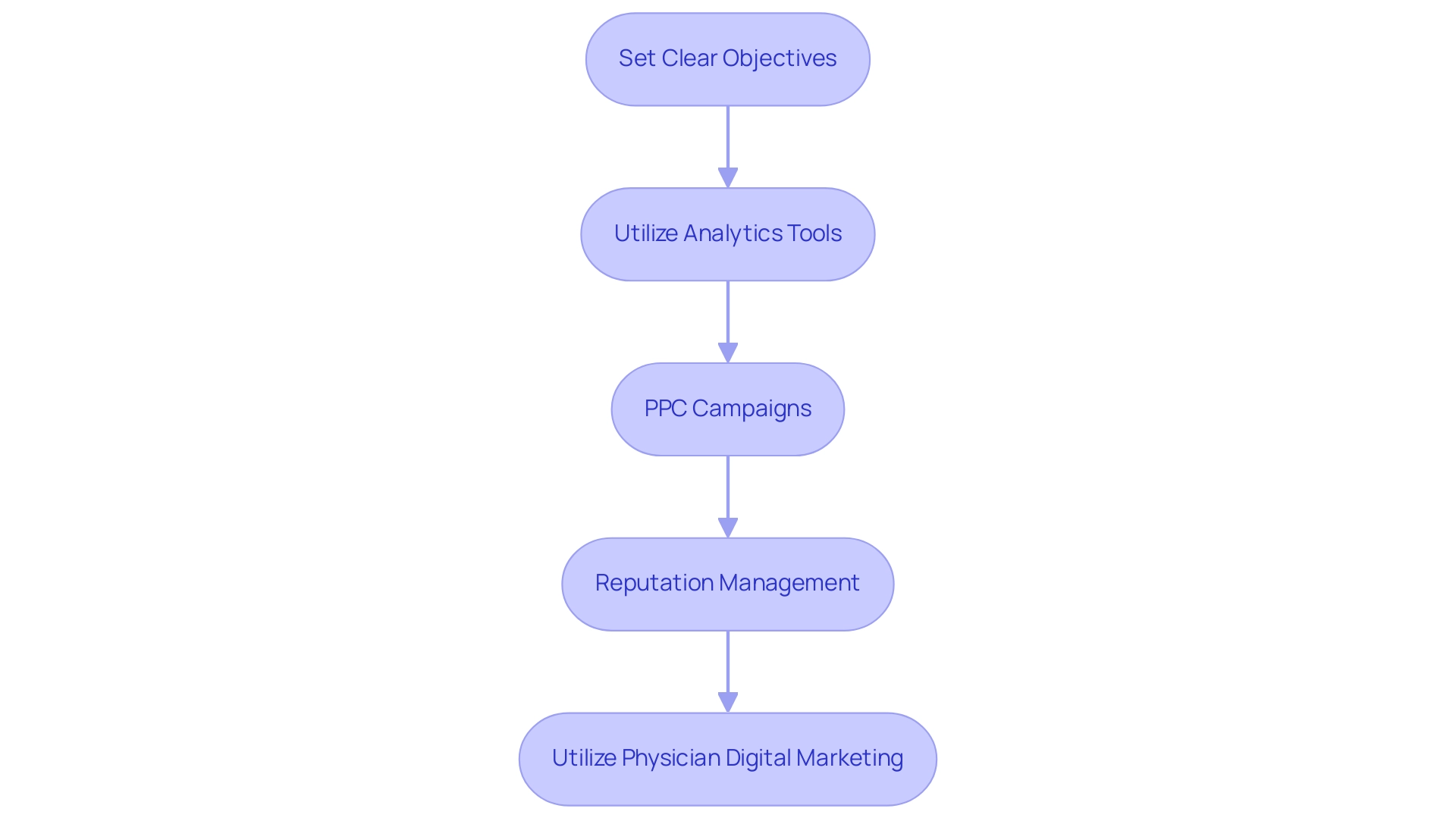
Future Trends in Physician Digital Marketing
To maintain a competitive edge in physician digital promotion, it is essential to consider the following future trends:
-
Telemedicine Integration: With telehealth adoption soaring, particularly among women (42%) and men (31.7%), it is crucial to incorporate online consultation options into your marketing strategy. This shift reflects the growing acceptance of virtual care, emphasizing the role of physician digital marketing, as recent statistics show that 25.1% of medical specialists utilized telemedicine for 25% to 49% of their visits. As Kelly L. Myrick, Ph.D. noted, the COVID-19 pandemic led to a dramatic increase in telemedicine use, rising from 15.4% in 2019 to 86.5% in 2021, highlighting the necessity for physician digital marketing integration.
-
AI and Chatbots: The utilization of AI-driven tools and chatbots can significantly enhance user interaction and streamline communication processes. These technologies not only enhance operational efficiency but also play a crucial role in physician digital marketing by addressing the growing demand for prompt responses from individuals, which is becoming a standard expectation in medical services. Statistics indicate that AI and chatbot usage in healthcare has risen sharply, with many providers utilizing physician digital marketing to report enhanced satisfaction and engagement among users.
-
Tailored Promotion: An emphasis on customized promotional strategies that cater to individual client needs and preferences will connect more effectively with your audience. Tailoring content and communication using physician digital marketing can foster deeper relationships and loyalty, which is vital in a competitive landscape.
-
Video Content: Adopting video promotion strategies is becoming more essential as video content continues to gain traction. Involving individuals through educational videos can improve comprehension and connection, making it a powerful resource in your physician digital marketing efforts.
-
Internet of Medical Things (IoMT): Incorporating IoMT devices into your practice can yield significant financial benefits. Goldman Sachs predicts that IoMT devices could save medical providers up to $300 billion each year by minimizing adverse events and optimizing service costs. This financial incentive further supports the integration of telemedicine and AI tools into physician digital marketing strategies.
By staying attuned to these trends, physicians can proactively adapt their physician digital marketing efforts to align with the evolving expectations of patients, ultimately promoting sustained growth and effective branding in the healthcare industry.
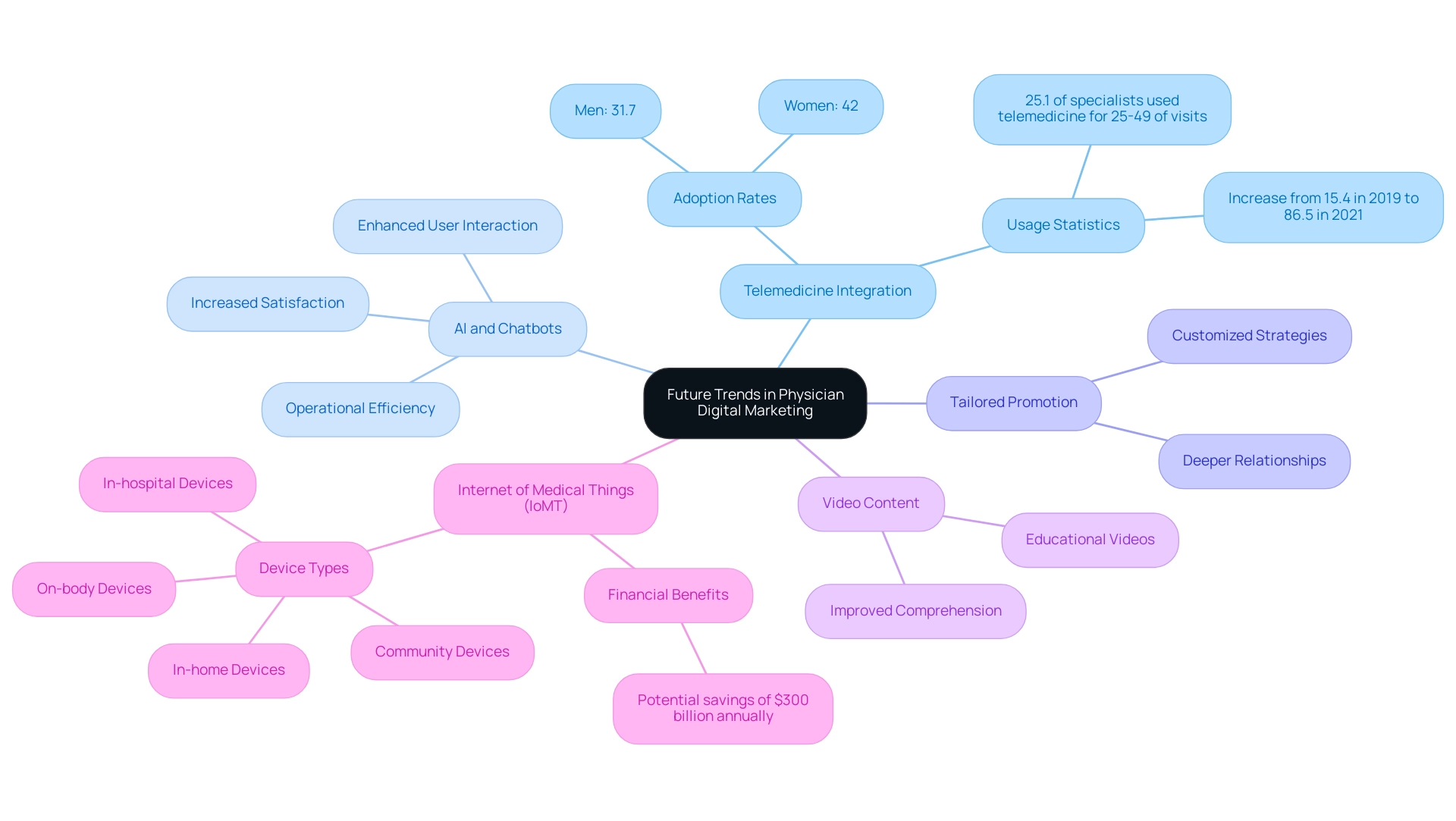
Conclusion
The digital marketing landscape presents significant opportunities for physicians to enhance their online presence and connect with patients. Understanding the digital environment is crucial, as patients increasingly rely on online resources for healthcare information. By optimizing websites, utilizing local SEO, and creating high-quality content, physicians can attract and retain patients effectively.
Moreover, leveraging social media allows practices to engage with their audience actively, building trust and fostering community. Regularly posting informative content and responding to patient inquiries can enhance visibility and strengthen relationships. The integration of data-driven marketing strategies further empowers healthcare providers to make informed decisions, optimize campaigns, and manage their online reputation.
As the healthcare sector continues to evolve, staying ahead of trends such as telemedicine, AI integration, and personalized marketing will be essential for sustained growth. By embracing these strategies, physicians can not only meet the changing expectations of patients but also thrive in an increasingly competitive digital landscape. Prioritizing an effective online presence is not merely an option; it is a fundamental necessity for modern healthcare practices aiming to succeed.

